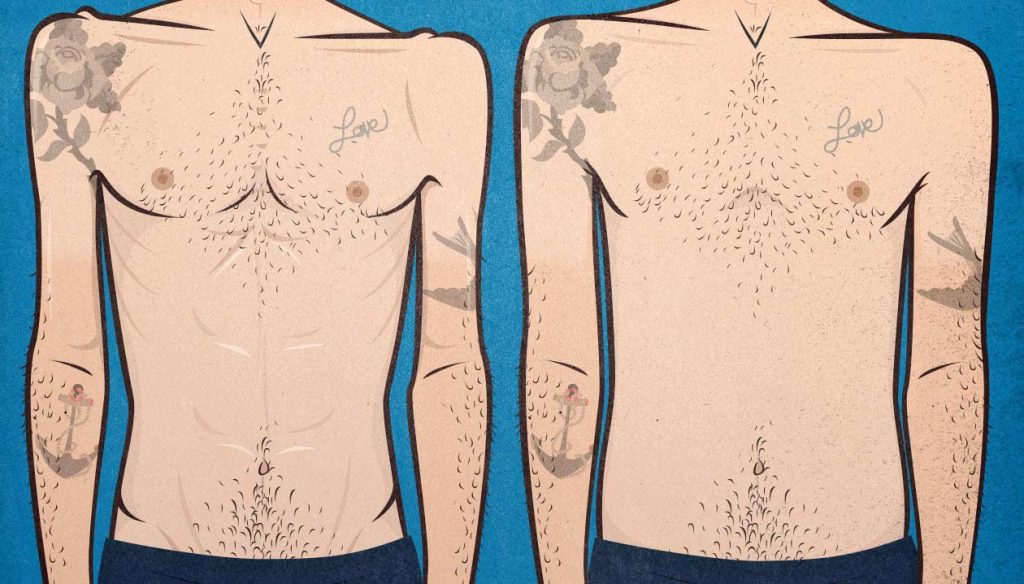
The Skinny Guy’s Guide to Body-Fat Percentage
As a skinny guy, it can be hard to figure out what your body-fat percentage is. Imagine the average man. A DEXA scan measures him at 24% body fat. Then he sits in the BodPod, which puts him at 26%. A bit of a discrepancy, but he can be reasonably confident he’s between 24–26%.
Now you walk in, and DEXA puts you at 9%. Not only are you lean enough to bulk aggressively, but you’re also leaner than most professional athletes. You may even want to gain a bit of fat. But when you step into the BodPod, it measures you at 22% body fat. That’s a bit high. You might want to lose some fat.
You’ve spent a few hundred dollars getting the two most accurate tests, and you don’t even know if you have too much or too little fat. The typical margin of error is something like 5% body fat in either direction (article). That means if you get a reading of 20%, you’re probably between 15–25% body fat. That isn’t always the case, though. With skinny guys, DEXA and BodPod can be off by up to 13%!
So in this article, we cover why your body-fat percentage matters, how to measure it properly, and then run through some real-life examples (with pictures).
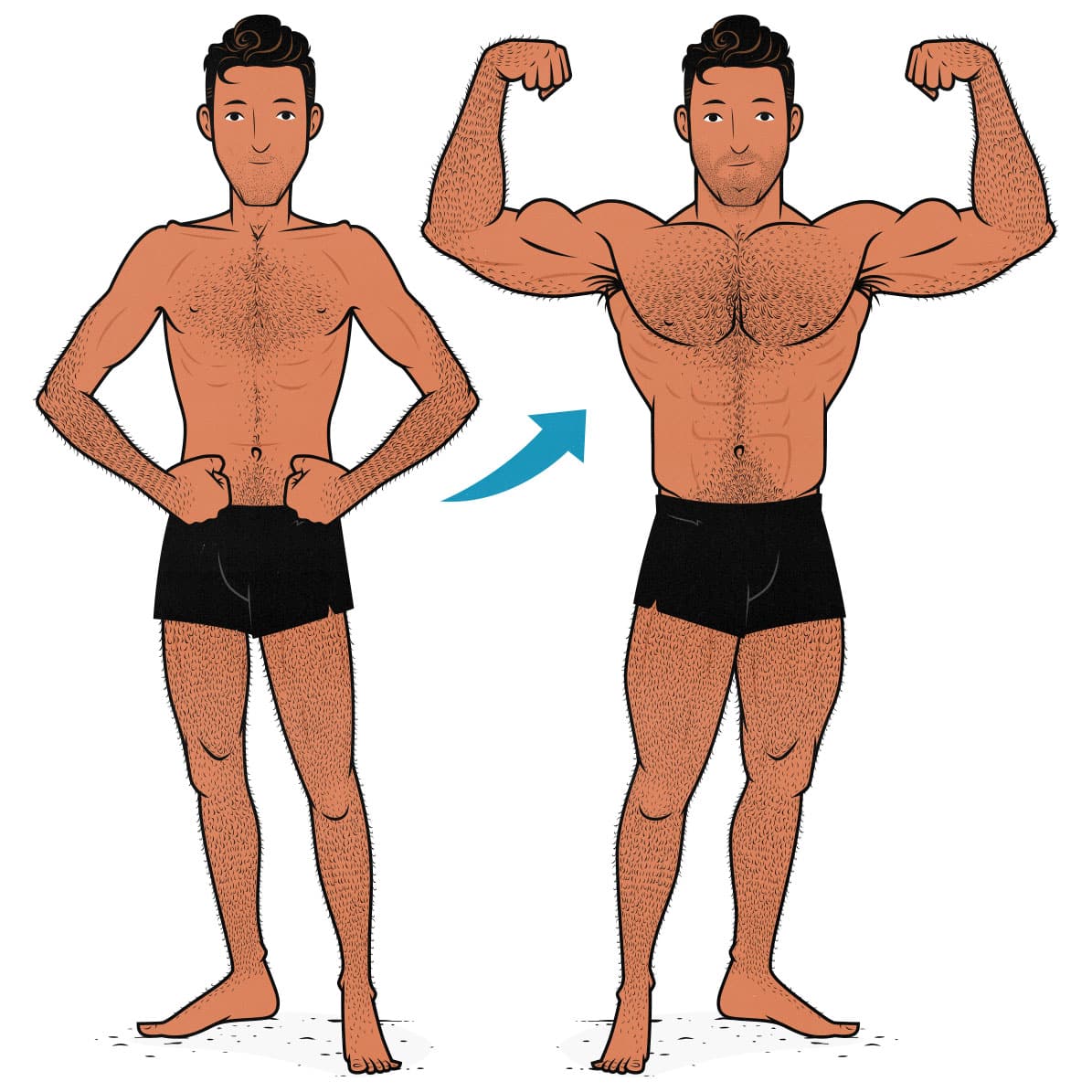
How Lean is Too Lean?
The body-fat percentage range starts at around 8–12%, depending on the person (study). When you get leaner than your body wants to be, your fat cells get hungry, cortisol levels rise, and testosterone drops (study). That makes it harder to build muscle and easier to gain fat. This gets increasingly extreme as our body-fat percentage drops lower.
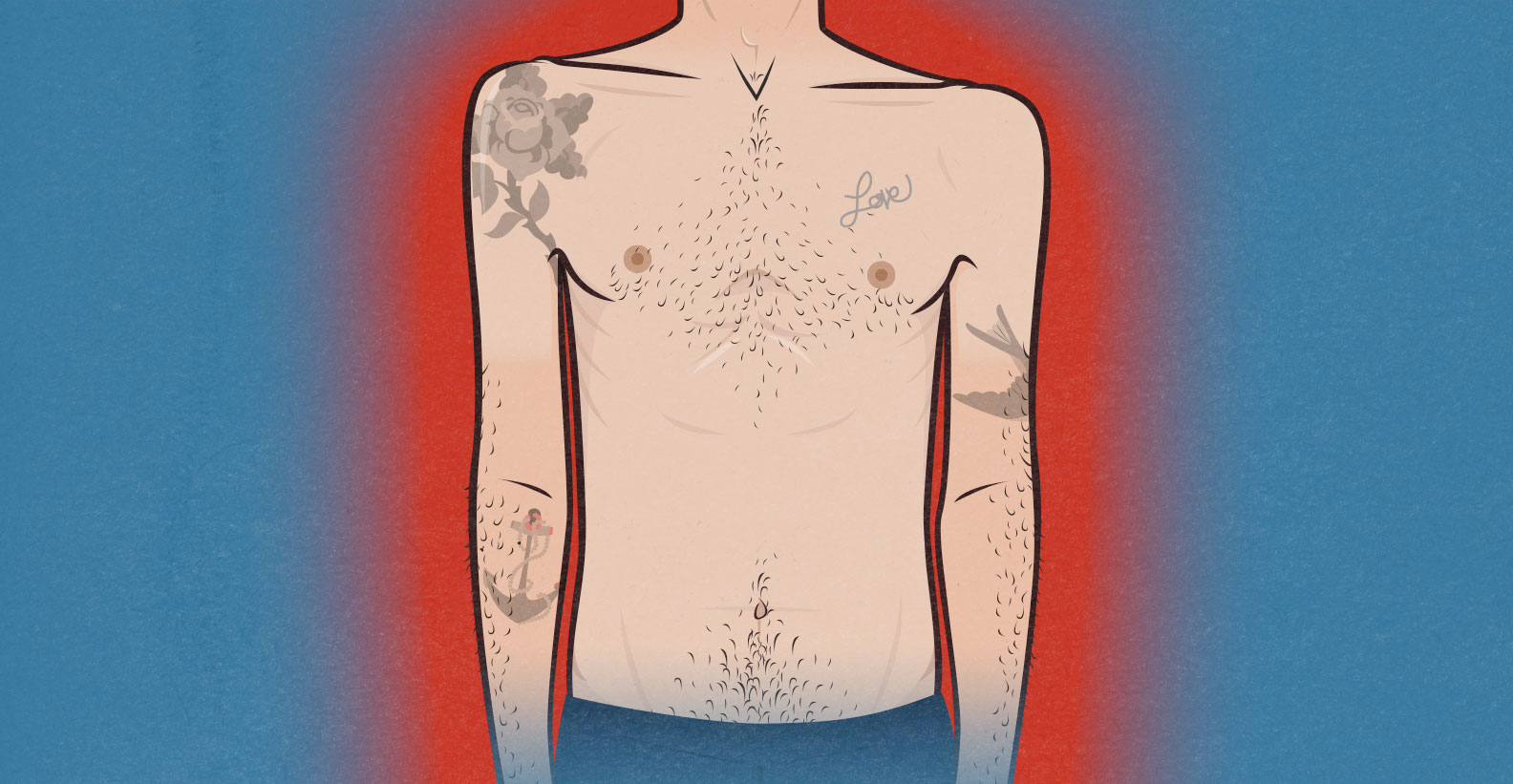
When a bodybuilder steps off the stage and starts eating a normal amount of food again, he’ll often gain 10–20 pounds of pure fat. That’s a good thing. His body needs fat more than it needs muscle. When his body is happy with his body-fat percentage, he can start building muscle again. Maybe that’s at 8%. Maybe it’s at 12%.
Fortunately, unless you’re a bodybuilder, you never need to get that lean. Muscles look good at very low body-fat percentages, but it often makes our face look gaunt. We get the “death face.” Our necks often start looking thin, too. That’s why most guys look better when they’re above 8–12% body fat.
How Fat is Too Fat?
There’s some debate about when fat starts to pose a risk to our health. People throw around is 20% as the cut-off point, but it’s a bit more nuanced. It depends on what type of fat we’re storing. The fat around our organs (visceral fat) has a bigger impact on our health than the fat right underneath our skin (subcutaneous fat).
Fortunately, if we measure our waist circumference, we can get a good idea of how much fat’s accumulating around our organs. The National Institutes of Health recommend keeping your waist circumference under 40 inches (reference). If you want to play it totally safe, you can keep your waist circumference under 36 inches.
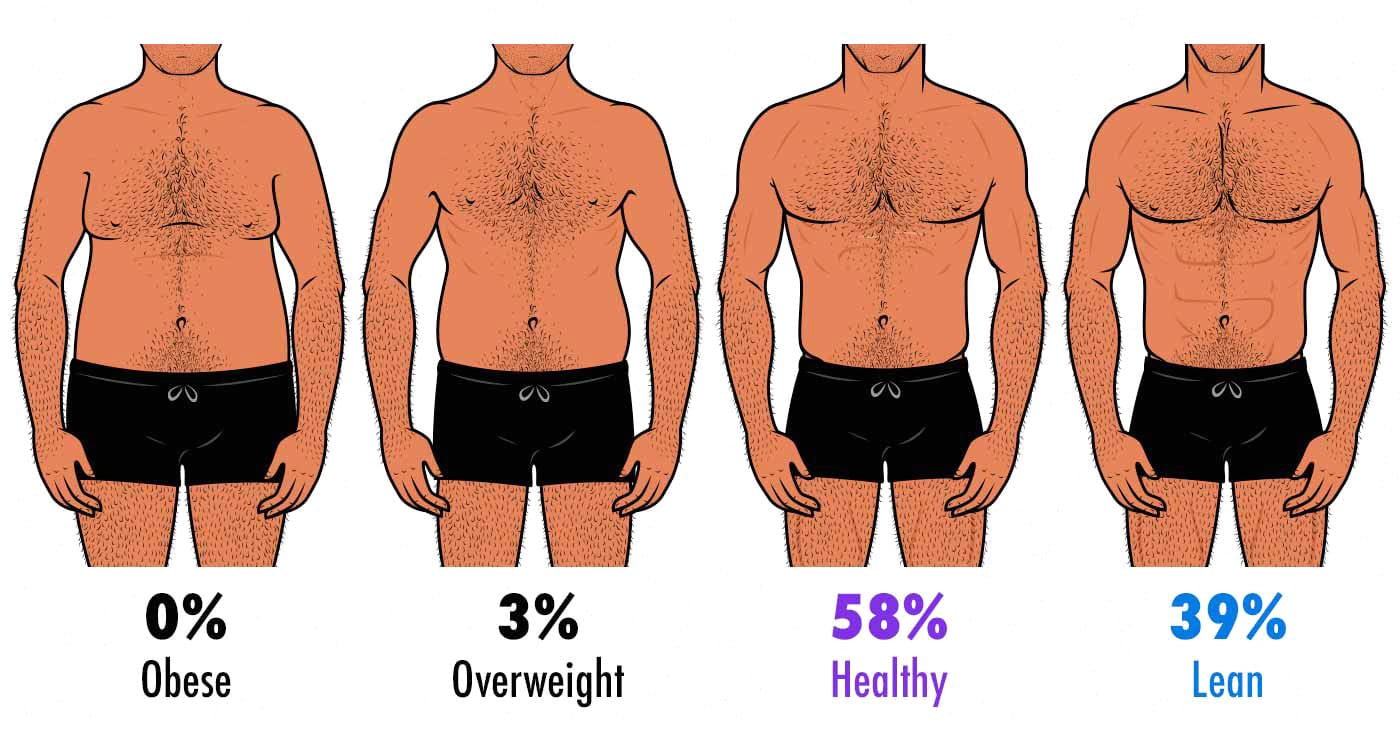
Most skinny are afraid of gaining fat because of how it looks, though. In that case, most guys look their best at around 10–15% body fat (reference). If you’re muscular, you might be able to pull off a body-fat percentage closer to 20%.
The final concern is how body fat affects muscle growth. There’s a myth among bodybuilders that getting too fat impairs muscle growth. That doesn’t seem to be true. It seems that the fatter someone is, the more easily they tend to lose fat, and the more leanly they tend to build muscle. We’ve written a full article breaking down that research.
So, if you’re skinny-fat, you don’t necessarily need to start by getting lean. You could also start by staying at the same body weight (body recomposition) or with a lean bulk. For more, we’ve got a full article for skinny-fat guys.
How to Estimate Your Body-Fat Percentage
We’ve already covered why DEXA scans and BodPods won’t work properly until you’ve already bulked up to a solid weight. Let’s go over some of the other common methods.
Bioelectrical Impedance Analysis (BIA scales)
Are bioelectrical impedance analysis scales (BIA) an accurate way of measuring body-fat percentage? No, BIA scalres are cheap and convenient—most modern bathroom scales have this feature—but they’re even less accurate than DEXA and BodPod. Again, they’re just not something designed for guys like us. They’re for tracking fat loss in overweight people, not muscle gain in skinny guys.
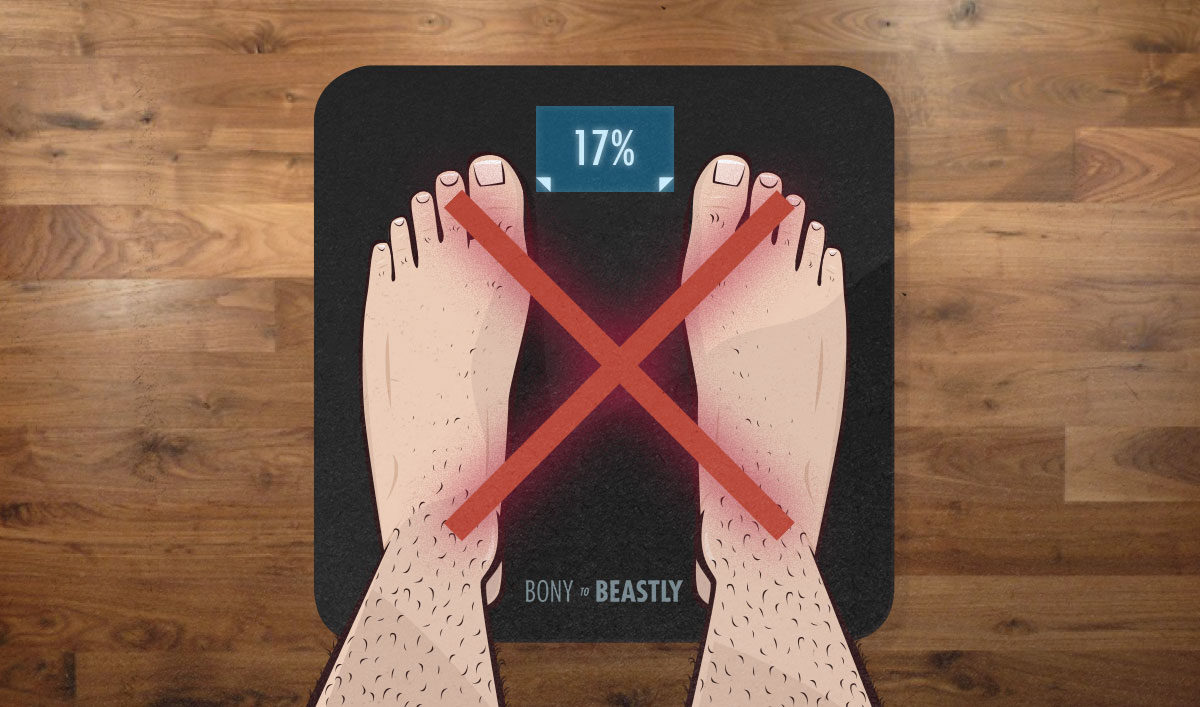
When I was bulking up from 130 to 170 pounds, my BIA scale started at 10% and climbed all the way to 20%. That made me anxious, but my abs looked the same as they always did. My waist circumference wasn’t exploding, either. Where was all the extra fat going?
Something strange happened when I made it up to 185 pounds. My BIA scale decided I had an “athletic” body composition, so it switched to a different algorithm. Instead of 20% body fat, it measured me at 8%. I was so frustrated that I got rid of the scale and bought a simpler, cheaper one that wouldn’t try to measure my body-fat percentage.
The Bodybuilder Method (Skinfold Calipers)
Skinfold callipers are the opposite of the Navy Method, good for aesthetics but not health. They can’t probe beneath your muscles, so they can’t tell you how much visceral fat you’re storing. But they can tell you how much fat is clouding your muscle definition.
Callipers are also difficult to master. There’s an art to getting precise measurements. Your first few months of using them may not be all that fruitful. Still, they’re affordable, you can use them from the comfort of your home, and they can work well if you’re willing to practice.
The Mirror Method
This is my preferred method of guesstimating body-fat percentage. It isn’t perfectly accurate, but it doesn’t need to be. It doesn’t really matter if you’re 13% body fat or 15% body fat. Both of those body-fat percentages are healthy and look good. All that matters is whether you like how you look and whether you can gauge your progress (or lack thereof). The mirror method is quite good for that.
- If you’re bulking: make sure you’re getting stronger every week. Every 4–8 weeks, measure your body parts (including your waist) and take some progress photos. When you compare your measurements and progress photos, you’ll get an idea of how much fat you’re gaining.
- If you’re cutting: try to get stronger, or at least maintain most of your strength. Every 4–8 weeks, measure your body parts (including your waist) and take some progress photos. When you compare your measurements and progress photos, you’ll get an idea of how much fat you’re losing.
We help members with this as they go through our bulking program. There’s an art to it, but mostly it helps to get feedback from someone else. Some guys are overly hard on themselves. Others will happily bulk themselves into oblivion.
The Navy Method
The Navy Method uses your height and weight as a starting point, but the magic comes from factoring in your waist and neck circumferences. It sounds like it’s too easy, but it’s actually one of the more best ways to estimate your body fat percentage, especially if you lift weights. It’s quite a bit more accurate than the BIA scales most people use. It’s also very easy. All you need is a tape measure and this calculator.
Here’s how it works: Waist size is a good proxy for body fat levels, except for the fact that it gets bigger when you build bigger abs, obliques, and lower back muscles. That’s where the neck measurement comes in. Neck size is a good proxy for muscularity. Sort of. Body fat can also make your neck thicker. But if we compare it against your waist, it works quite well:
- If your waist and neck are thin, you’re thin.
- If your waist is thin but your neck is thick, you’re lean.
- If your waist is thick but your neck is thin, you’re overweight.
Waist Circumference
Most people don’t need to know their body fat percentages; they just need to know whether they’re moving in the right direction and when it’s time to bulk or cut.
- If your waist circumference is under 36 inches, you’re cleared to bulk.
- If your waist circumference is 36 inches, it’s time to stop bulking.
- If your waist circumference is over 36 inches, consider cutting.
- If your waist circumference is over 40 inches, we recommend cutting.
How to Visually Estimate Your Body-Fat Percentage
To use the mirror, you need to know what different body-fat percentages look like. Unfortunately, most body-fat comparison charts make that hard for skinny guys. Here’s a good example of a chart that doesn’t help us. Unless you’re an intermediate lifter at 15% body fat, good luck finding yourself on the chart.
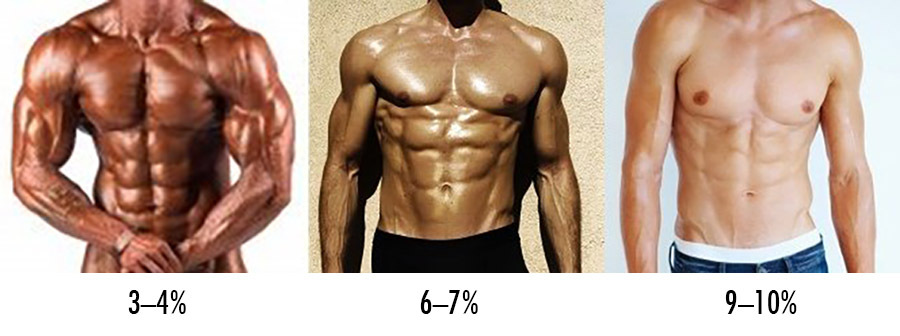
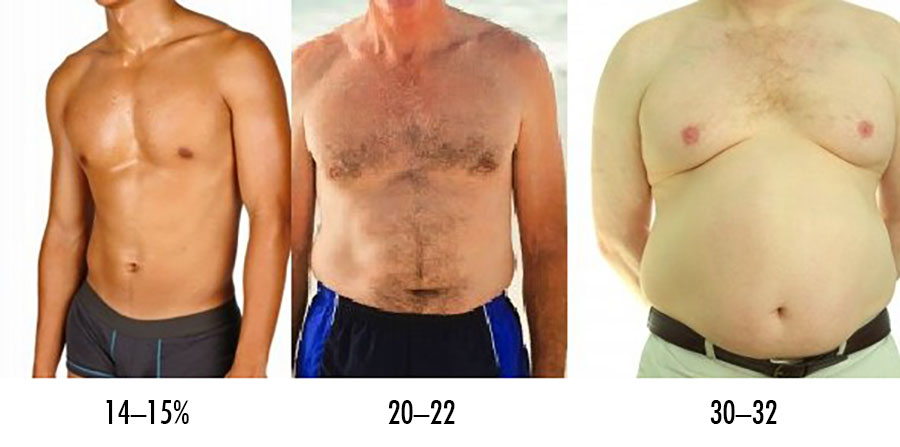
This chart is from Steve Kamb over at NerdFitness. I chose it because I like NerdFitness. Steve makes this same point in his article Everything You Need to Know About Body-Fat Percentage: muscle mass has a huge impact on how lean you look. I couldn’t agree with him more. Let me show you why.
Here are GK’s progress photos while doing The Bony to Beastly Program. He managed to stay at around 10% body fat the entire way through, but you can see he started with almost no muscle definition and finished looking totally chiselled. This has nothing to do with fat, everything to do with muscle.
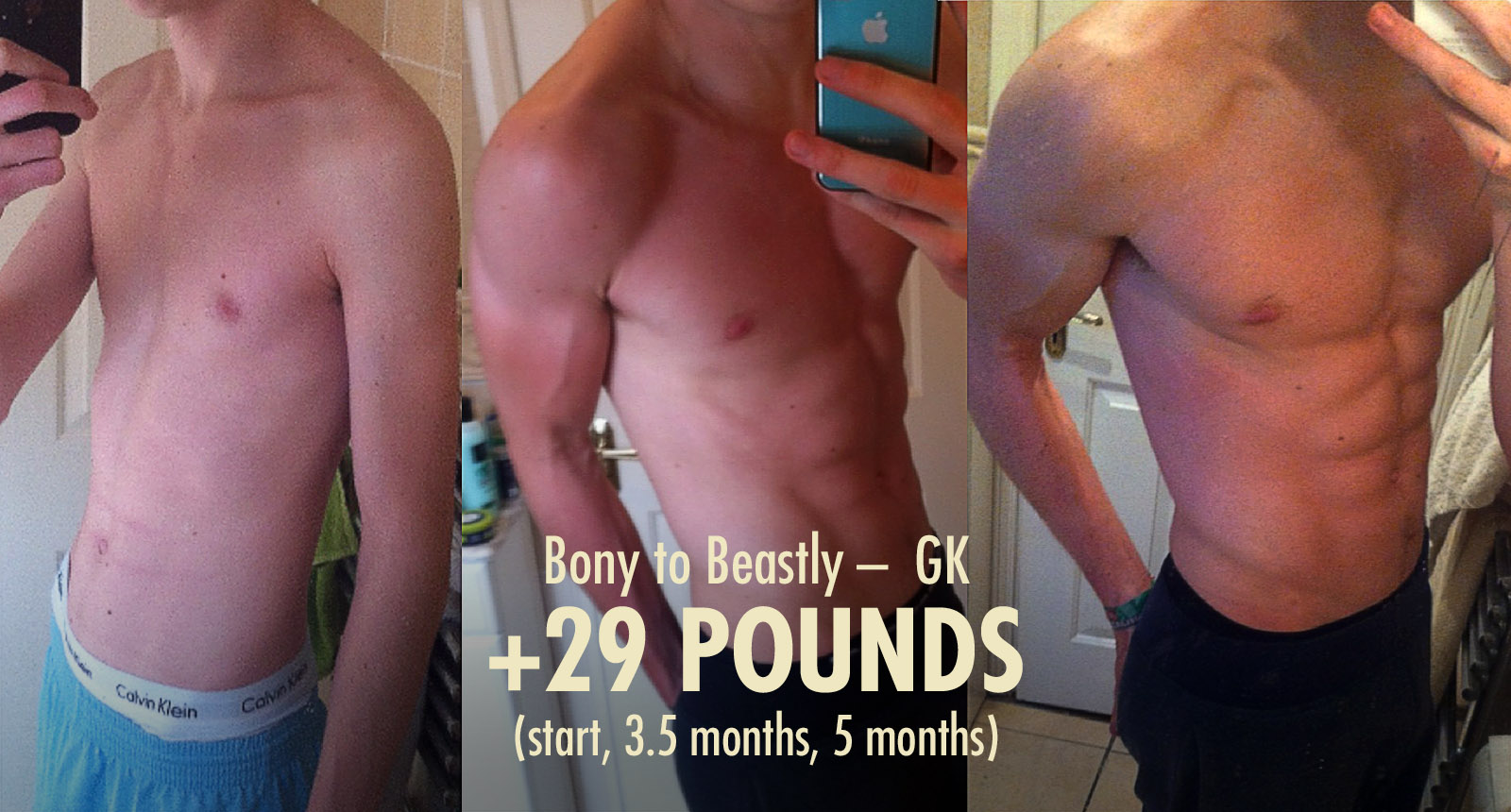
When you get a chart with chaotic variance in muscle mass, it’s impossible to compare the body-fat percentages. We can see the differences in muscle definition, but it’s unclear whether those differences stem from muscle or fat.
There are other problems with this type of chart:
- The guys have varying tans. How dark your skin is has a huge impact on how lean you look. That’s why the bodybuilder has such an exaggerated spray tan.
- Some guys are oiled up. Again, this is a trick used to make guys look leaner.
- Some guys pumped up their muscles for the photo. Another trick used to bring out vascularity and muscle definition, making guys look leaner.
- They’re different guys. One guy might have proportionally bigger ab muscles, another might have different body fat storage patterns, some will have different amounts of visceral versus subcutaneous fat.
- The lighting isn’t the same. Light is what casts shadows. Those shadows create muscle definition. If the light is changing, so will the shadows, and so will the muscle definition.
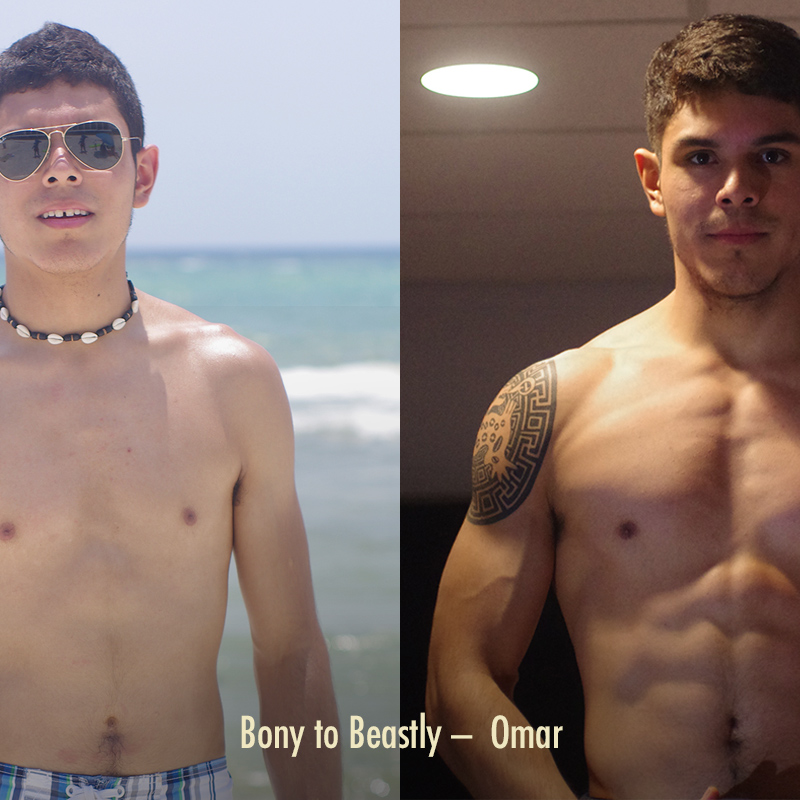
Here’s another example. You can see that Omar’s gained a ton of size in his chest, traps, shoulders, and arms, but is he leaner? It’s hard to tell when the lighting is so different.
As a rule of thumb, overhead lighting makes guys look leaner than ambient lighting. That’s why you probably look leaner in your bathroom mirror than on the beach (depending on the weather).
It’s even harder for so-called “ectomorphs.” Almost all of the charts are packed full of overweight and muscular guys. Where are all the skinny guys?
A Better Approach to Body-Fat Charts
I drew up some illustrations. I kept all of the variables constant: the same amount of muscle mass, the same lighting, the same poses, and the same bone structures. All that’s changing is the body fat percentage.
Perhaps more importantly, I’ll give you some milestones to look for. If you can see your upper abs, you’re likely under 15%. If you can see all your abs, you’re probably under 12%. These are helpful milestones. They also give you something to track as you’re bulking, cutting, or recomping.
We’ve got two charts:
- A naturally skinny guy who’s still thin.
- A naturally skinny guy who’s bulked up.
Here’s how you use the body-fat percentage charts:
- Find a mirror.
- Turn on some flattering overhead lighting (bathrooms work well).
- Flex your butt to rotate your hips into a neutral position.
- Flex your abs.
- Compare your abs and muscle definition to these charts
The Skinny Body-Fat Chart
Here’s what 9–20% body fat looks like on the typical skinny guy:
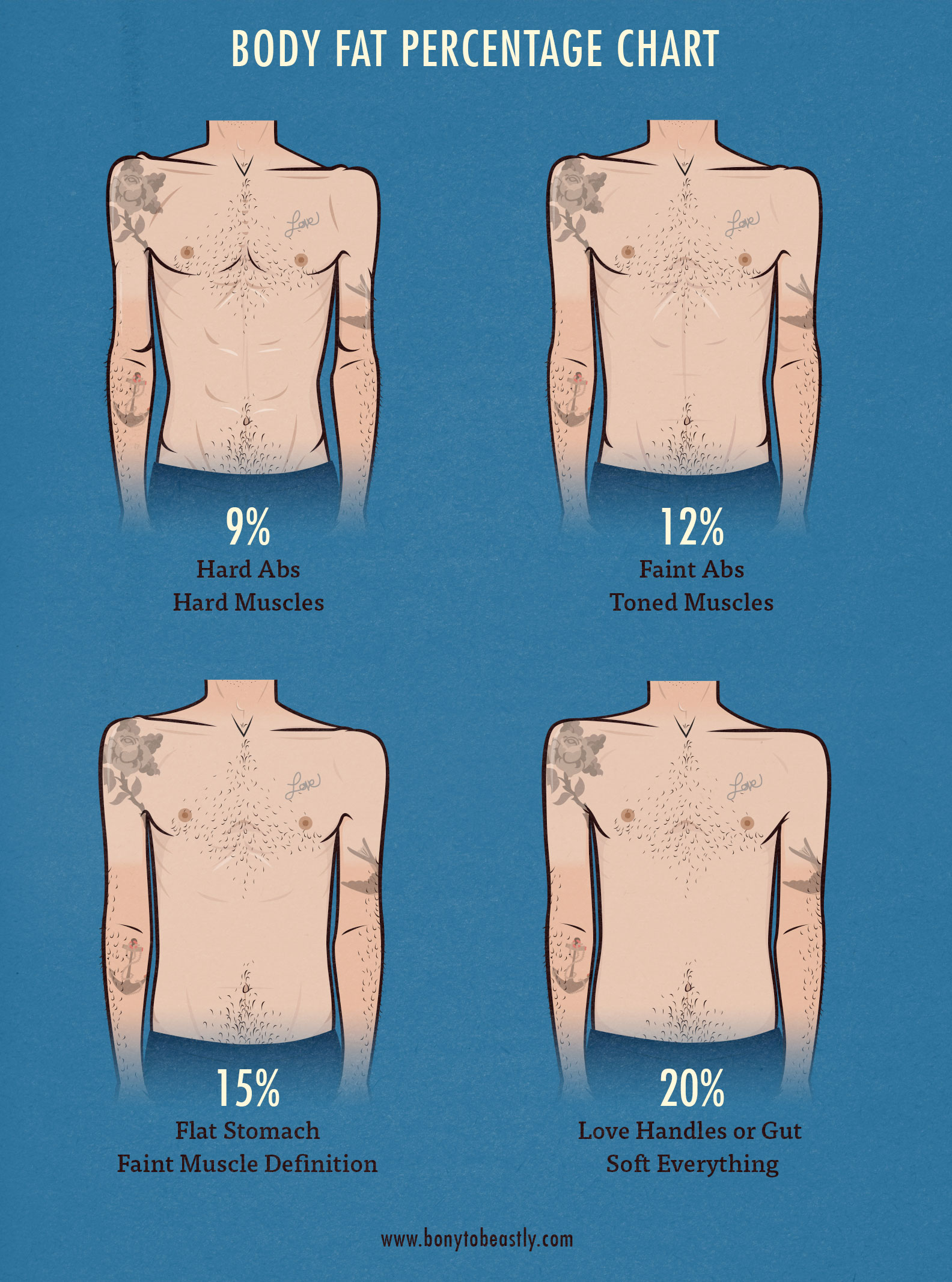
The Buff Body-Fat Chart
Here’s what 9–20% body fat looks like on a skinny guy after he’s bulked up:
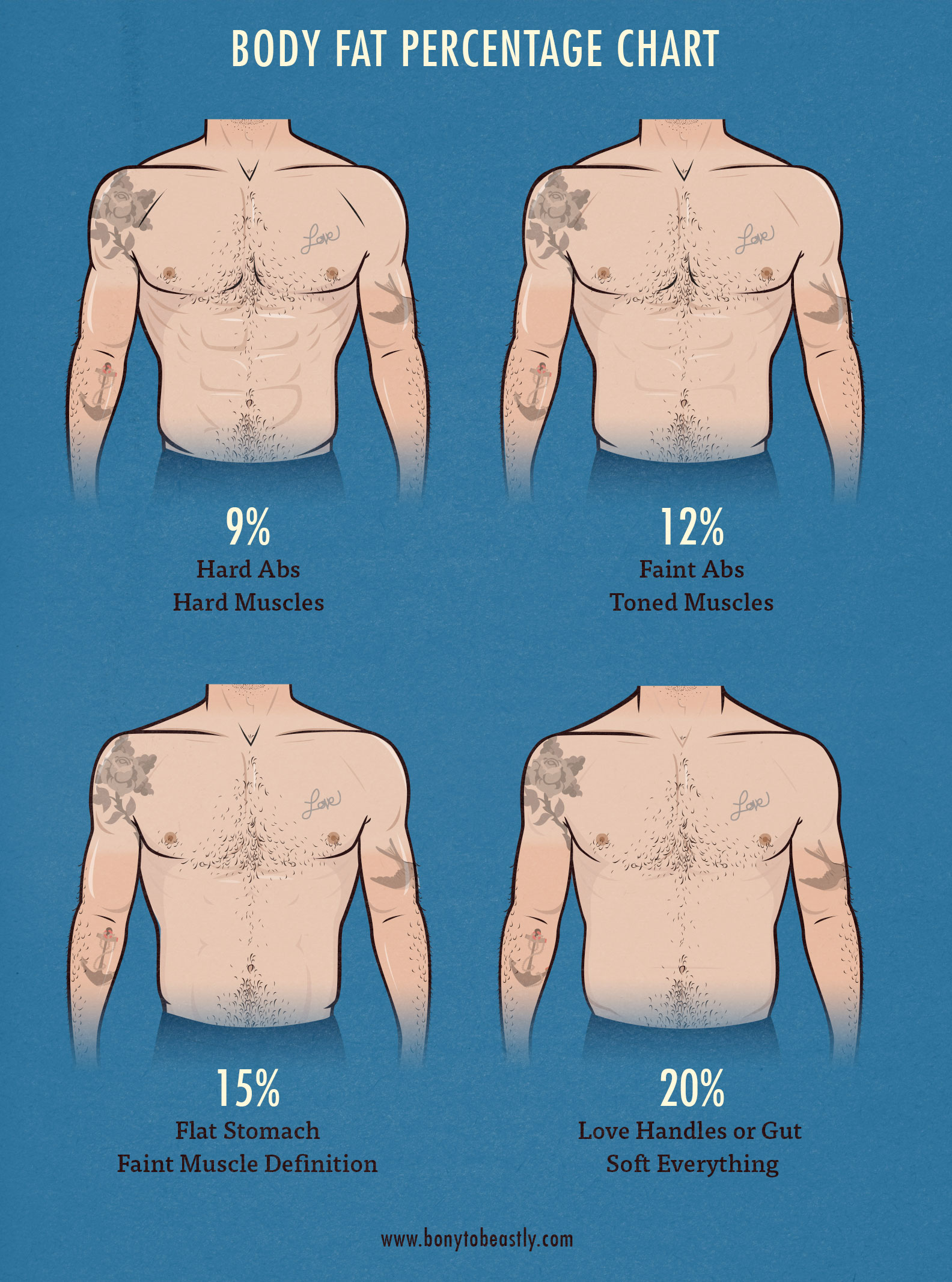
Real-Life Body-Fat Percentage Examples
Very Lean Body-Fat Percentages
Let’s review some bulking transformations of guys doing our Bony to Beastly Bulking Program. I’ll estimate what their body-fat percentages are both before and after. Remember that estimates don’t need to be perfect, just close enough, just useful.
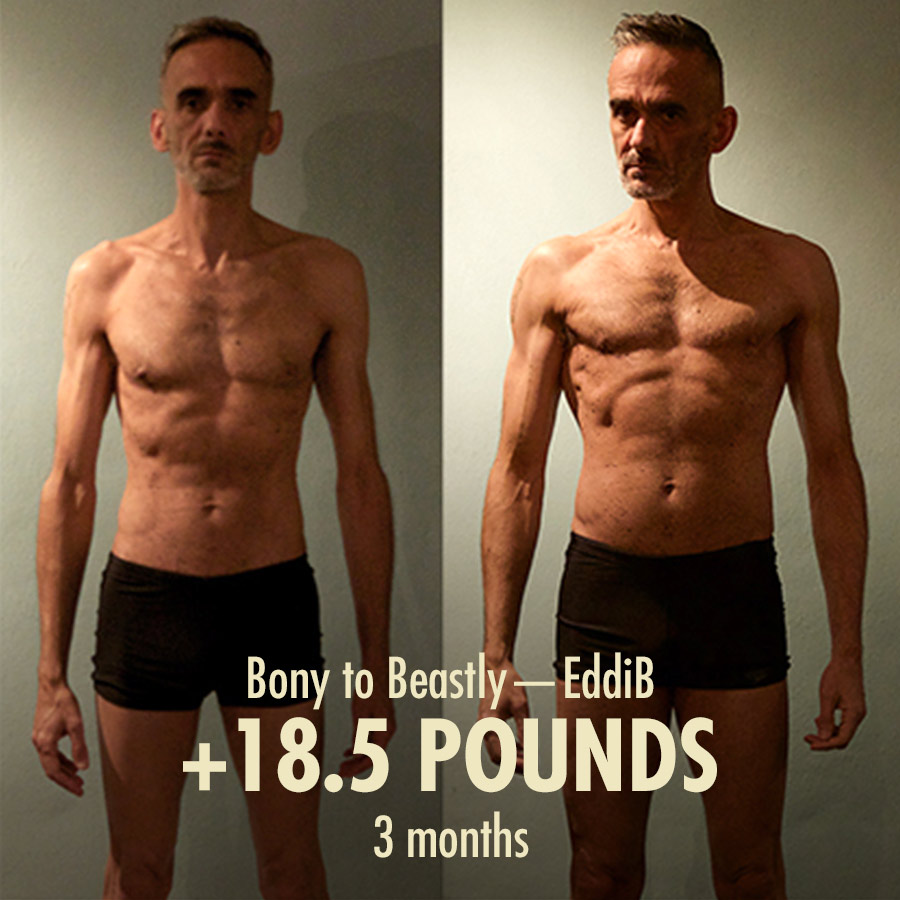
Here’s an example of bulking at a very lean body-fat percentage. Eddi is bulking up for his sixtieth birthday. It’s one of the transformations I like to send to 40-year-olds when they tell me they’re too old to bulk. I think he’s starting at around 8% and finishing closer to 10%.
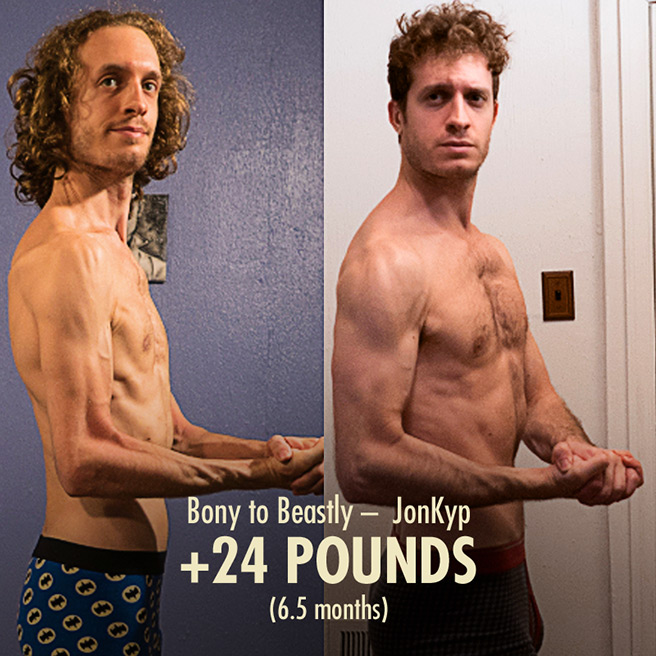
Here’s another lean body-fat percentage. Jon went from around 7% up to what looks more like 10%.
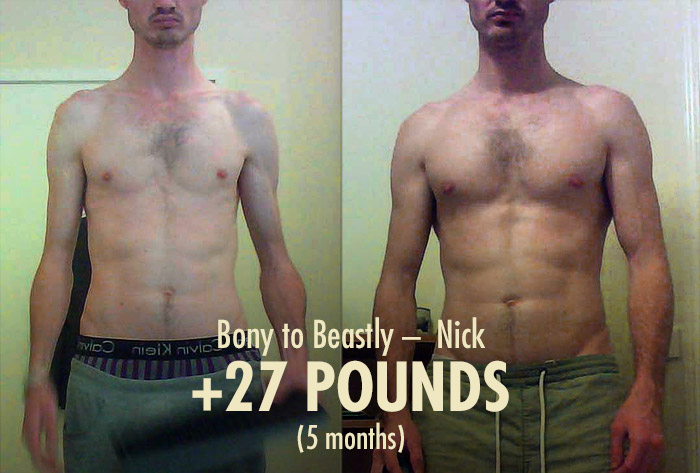
Here’s Nick starting at around 8% body fat. He’s quite lean after gaining 27 pounds, but I’d guess he’s climbed up to around 12% by the end.
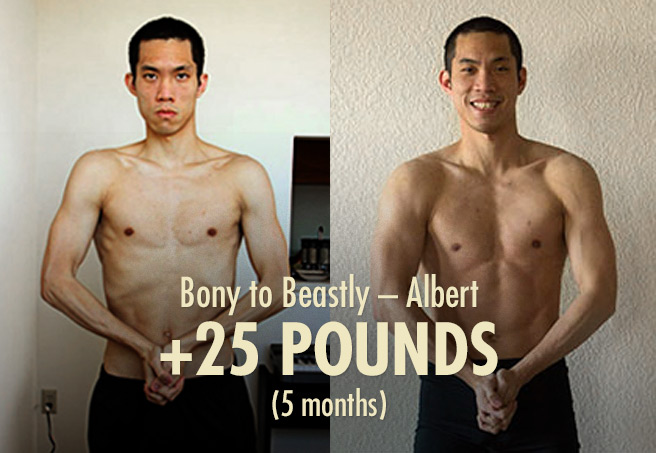
Here’s Albert starting and finishing at around 10%. You can see that his muscle definition goes way up as he bulks, even though he’s at around the same body-fat percentage.
Lean Body-Fat Percentages
Here’s me at 11% as measured by DEXA scan and 10% as measured by BodPod. Note that I’ve bulked up to a bodyweight of 185 (BMI of 24). I’m heavy enough for these methods to be fairly accurate.
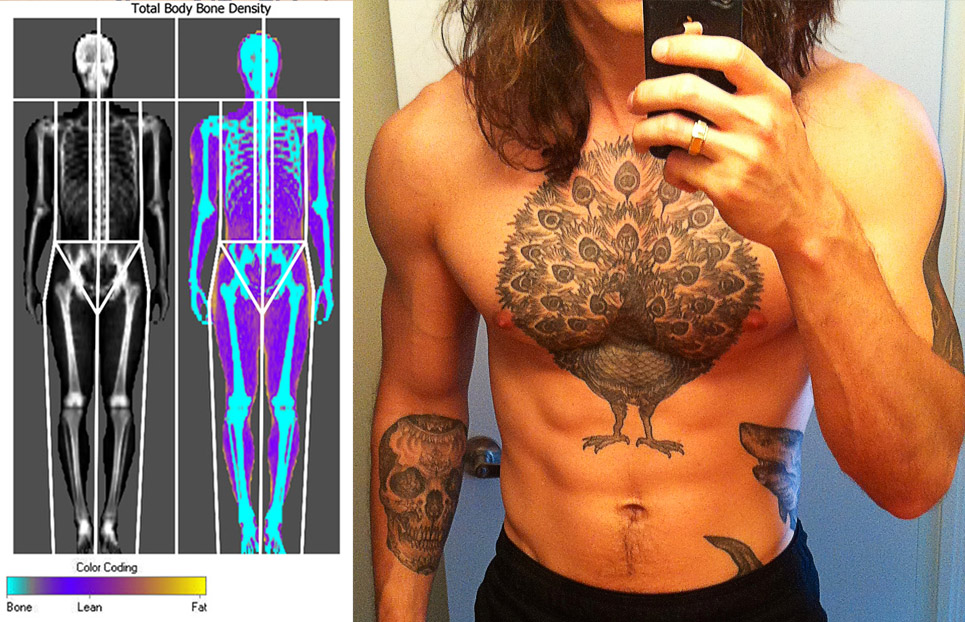
You can see that I’m not as lean as most of the transformations above. I’m more similar to the body-fat percentages you’ll see below.
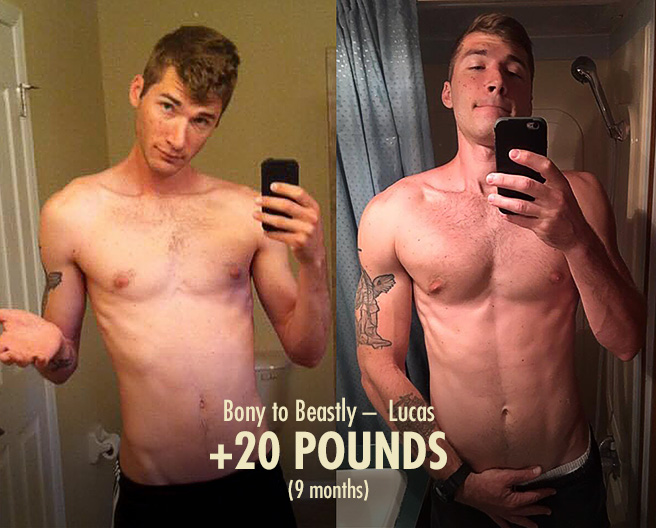
Lucas gained a bunch of muscle definition as he bulked up. He bulked slowly, steadily, and very leanly. He’s around 11% body fat before and after. Very similar to me.
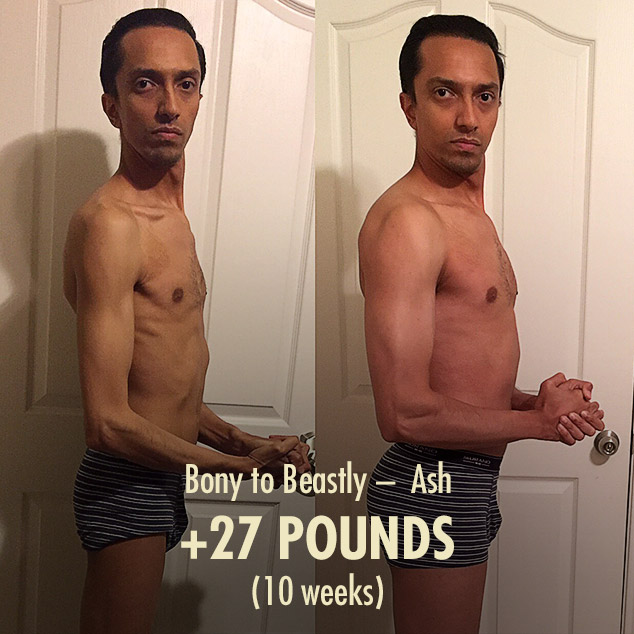
Here’s Ash gaining a couple of percentage points as he bulks, winding up looking better for it. Looks like around 10% to start, more like 13% at the end. Notice how aggressively he was bulking. Hard to keep your gains totally lean when you’re gaining 2.7 pounds per week.
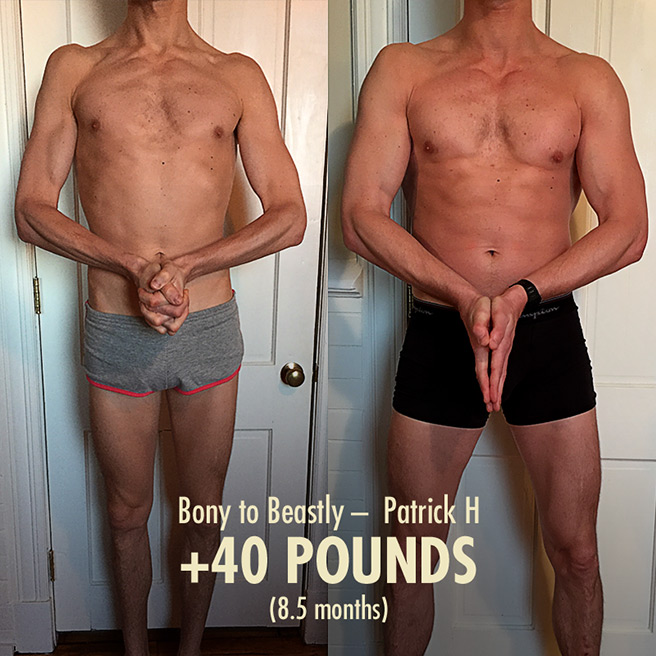
Patrick was around 11% starting out and around 16% at the end. This is a huge amount of muscle gain. He was able to keep his gains quite lean, given that he gained 40 pounds. I was impressed.
Normal Body-Fat Percentages
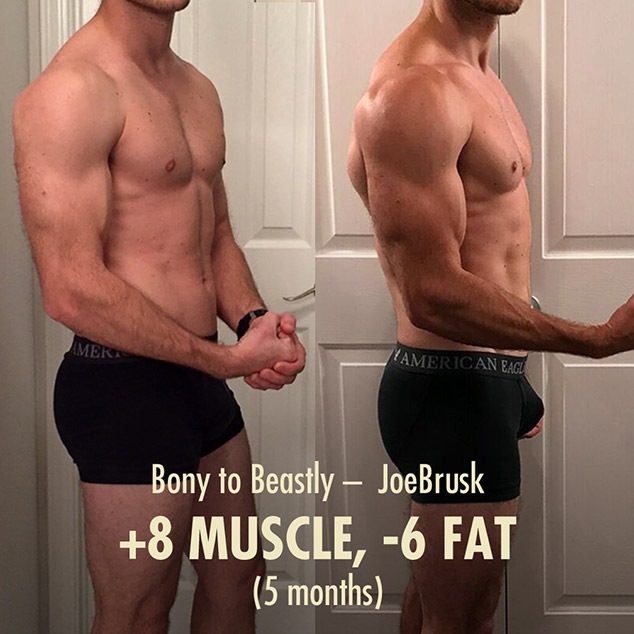
JoeBrusk was probably at around 15% at the beginning. After some body recomposition, he finished at around 10%.

John L started out at around 14%. He finished at around 15%. Impressive results given how muscular he started and how quickly he was gaining weight.
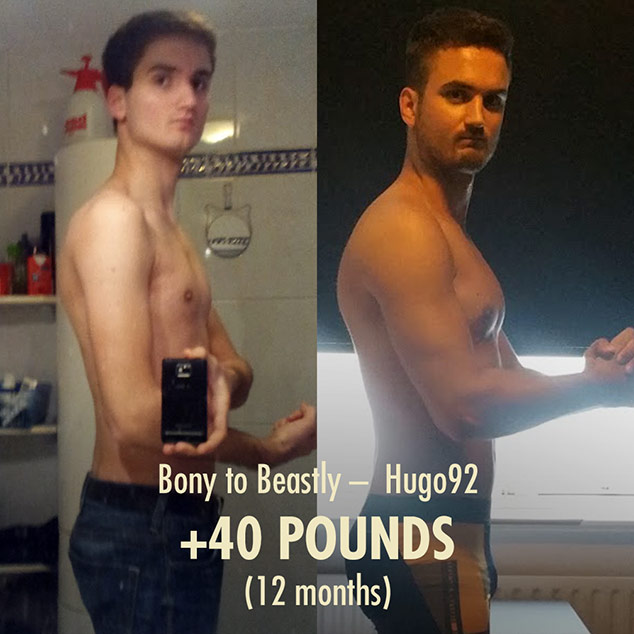
Here’s Hugo starting and around 11% and finishing at around 14%. What’s cool about this one is that he’s gained so much muscle that he’s got better muscle definition at a slightly higher body-fat percentage.
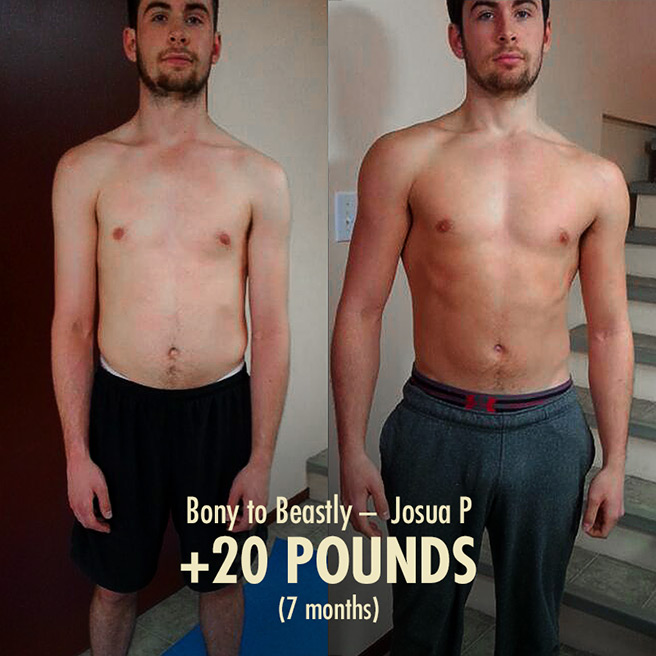
Josua is at around 17% body fat both before and after bulking, going from looking fit to looking quite athletic.
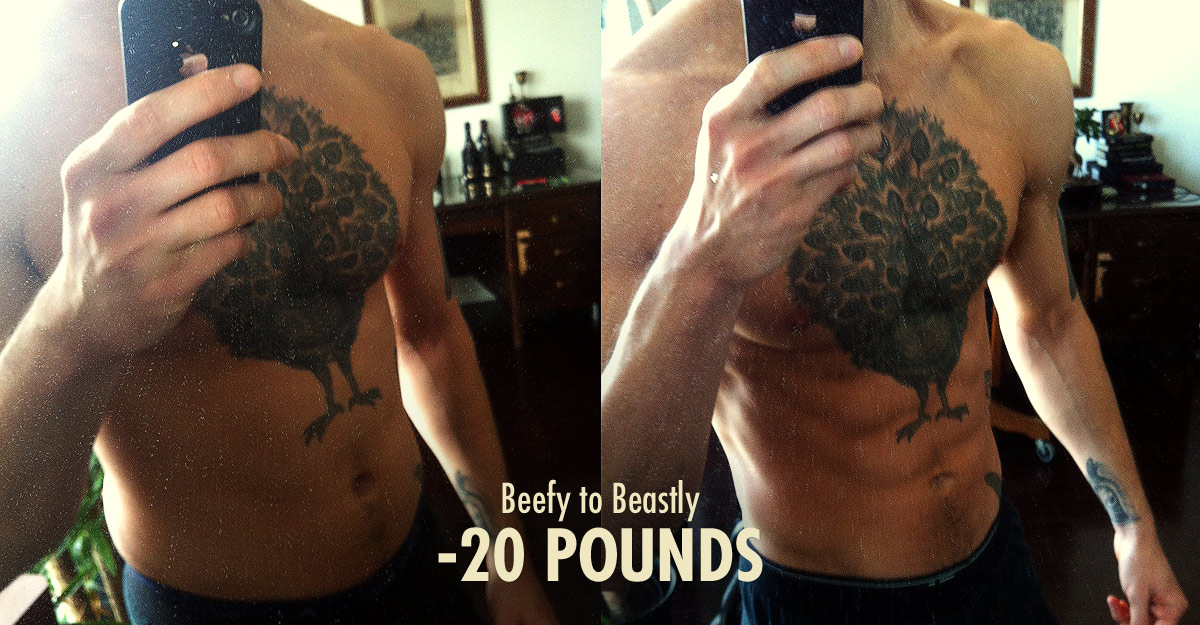
Here’s me cutting from 200lbs down to 180lbs. I started the cut at around 20% body fat and finished at around 10%.
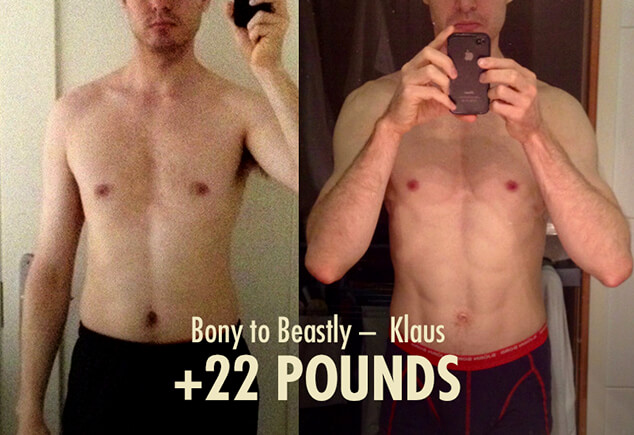
Klaus started at around 20% body fat. He did a bulk and a cut, finishing 22 pounds heavier at 8–10% body fat. Notice how much broader his shoulders have gotten and how much smaller his waist circumference is.
The End
Alright, that it’s for now. If you want more muscle-building information, we have a free bulking newsletter for skinny guys. It kicks off with a series about skinny genetics, how to eat and train for muscle growth, how to improve your appearance, and how to improve your health.
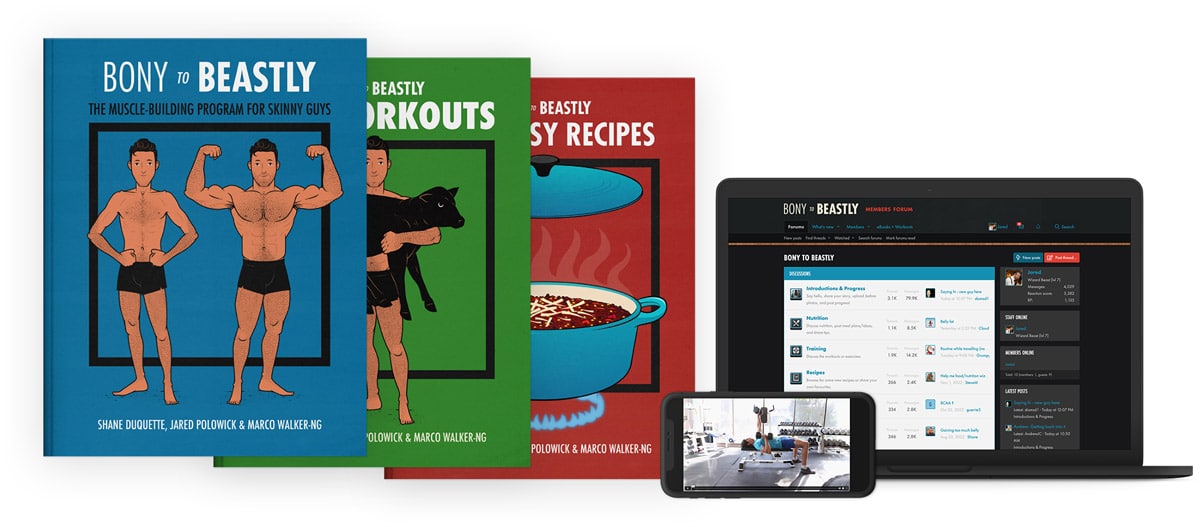
If you want a full bulking program, including a 5-month workout routine, diet guide, recipe book, and online coaching, check out our Bony to Beastly Bulking Program. Or, if you want an intermediate bulking routine, check out our Outlift Intermediate Bulking Program.

